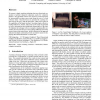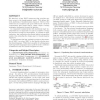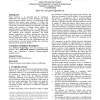5961 search results - page 1117 / 1193 » Design Science and Software Engineering |
ISESE
2003
IEEE
14 years 4 months ago
2003
IEEE
Pair programming is a practice in which two programmers work collaboratively at one computer on the same design, algorithm, code, or test. Pair programming is becoming increasingl...
VISUALIZATION
2003
IEEE
14 years 4 months ago
2003
IEEE
We present a haptic rendering technique that uses directional constraints to facilitate enhanced exploration modes for volumetric datasets. The algorithm restricts user motion in ...
DOCENG
2003
ACM
14 years 4 months ago
2003
ACM
We introduce a lazy XSLT interpreter that provides random access to the transformation result. This allows efficient pipelining of transformation sequences. Nodes of the result tr...
GROUP
2003
ACM
14 years 4 months ago
2003
ACM
Group awareness is an important part of synchronous collaboration, and support for group awareness can greatly improve groupware usability. However, it is still difficult to build...
SENSYS
2003
ACM
14 years 4 months ago
2003
ACM
Data dissemination from sources to sinks is one of the main functions in sensor networks. In this paper, we propose SEAD, a Scalable Energy-efficient Asynchronous Dissemination pr...



